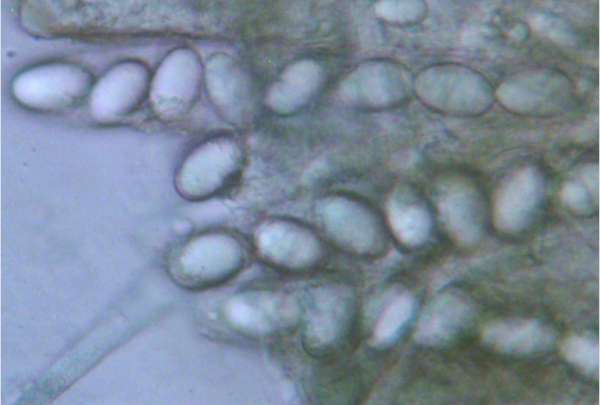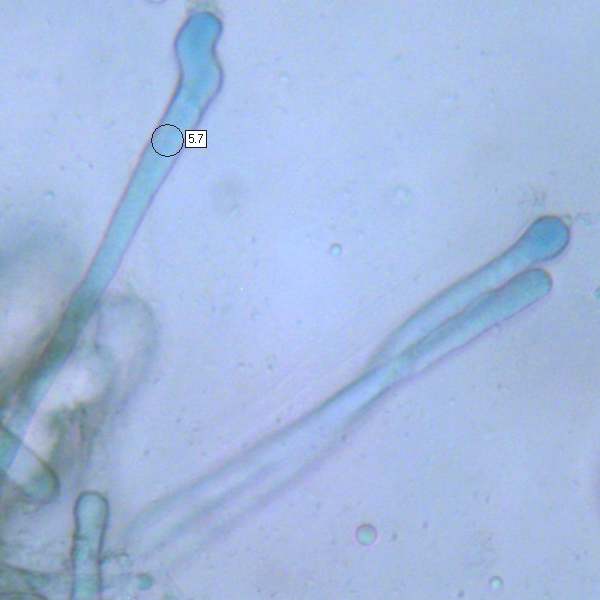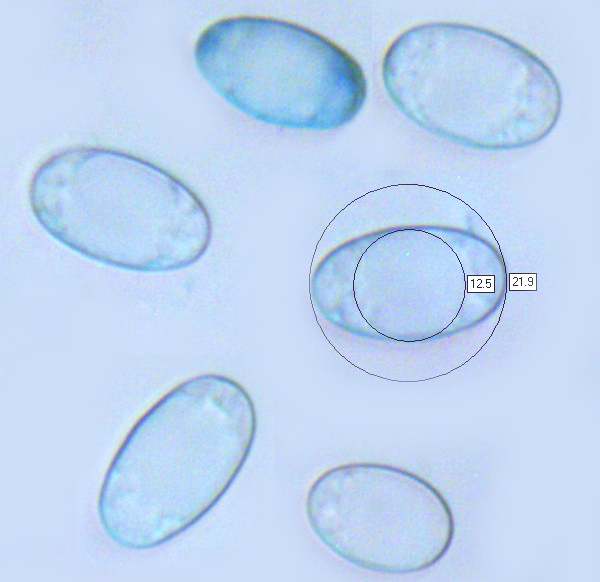Helvella elastica Bull. - Elastic Saddle
Phylum: Ascomycota - Class: Pezizomycetes - Order: Pezizales - Family: Helvellaceae
Distribution - Taxonomic History - Etymology - Identification - Culinary Notes - Reference Sources
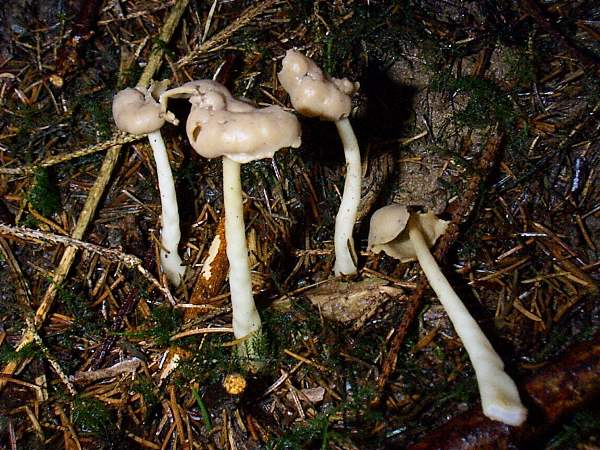
With their irregularly shaped saddles and pale stems, Helvella elastica fungi are most often found at the edges of forest footpaths, where they generally appear is small groups, sometimes forming neat lines as though queueing like taxi cabs hoping for fare-paying customers (woodland elves, I assume!).
Although traditionally considered saprobic, there are now suggestions that Helvella (saddle) fungi may be mycorrhizal.
Distribution
Fairly common in Britain and Ireland, particularly in conifer woodlands on acid soil, Helvella elastica occurs also throughout mainland Europe and in many parts of Asia. This species is also recorded from North America, where it is sometimes referred to as the Brown Elfin Saddle.
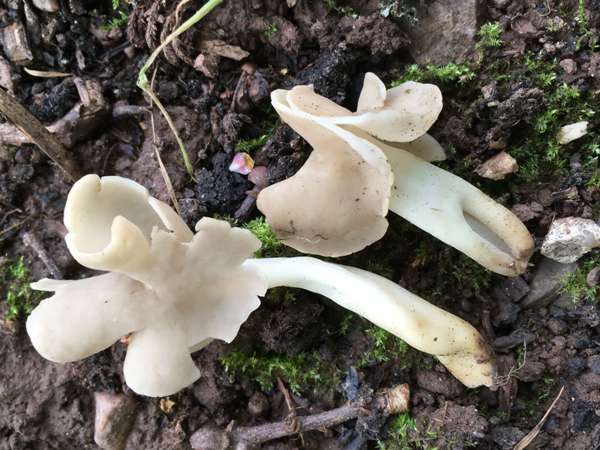
Taxonomic history
In 1785 when French botanist-mycologist Jean Baptiste Francois (Pierre) Bulliard described this woodland ascomycete he gave it the binomial scientific name Helvella elastica by which it is still generally known today.
Helvella elastica has several synonyms including Helvella albida Schaeff., Helvella fuliginosa Dicks., Helvella pulla Holmsk., Helvella klotzschiana Corda, Leptopodia elastica (Bull.) Boud., Leptopodia klotzschiana (Corda) Boud., and Leptopodia pulla (Holmsk.) Boud.
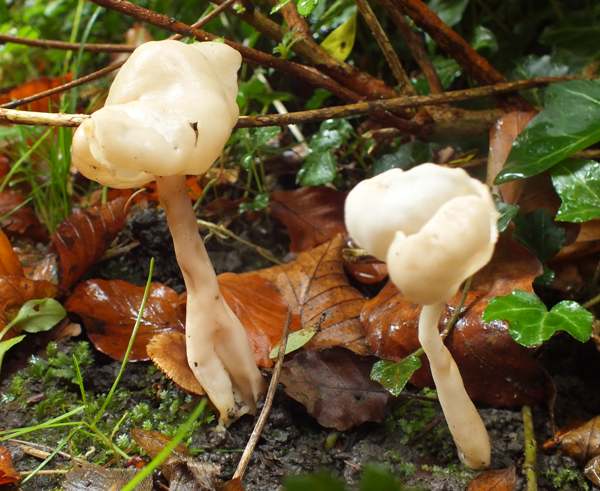
Etymology
Helvella is an ancient term for an aromatic herb. The specific epithet elastica comes from Latin and means elastic or flexible. (Elastic Saddle is one of the many other common names that this species has acquired.)
Mushrooms in this genus are sometimes referred to as Elfin Saddles, and you may wonder why not Fairy, Pixie or Goblin Saddles, for instance. American mycologist Michael Kuo offers a plausible answer when he reminds us that the original name that Elias Magnus Fries provided for the genus was Elvella rather than Helvella - so perhaps elves really do ride on these woodland fungi in the dead of night.
Identification guide
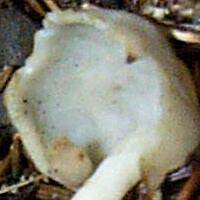 |
FruitbodyThe saddle-shaped caps of Helvella elastica are; typically 2 to 4cm across the cap and generally have just two lobes; they are usually less contorted than the caps of most other fungi of the Helvella genus. The smooth shiny outer surface of the cap bears the spores, while the infertile underside, illustrated here, is light ochre and finely matt. The long white stem is very rubbery and often appears to be twisted. Total height of cap plus stem is 5 to 10cm. |
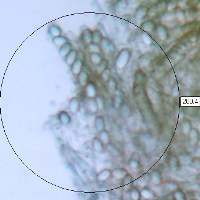 |
AsciTypically 300 x 17µm; eight-spored; inamyloid. |
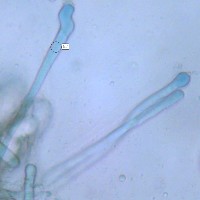 |
ParaphysesCylindrical, typically 6µm diameter, many with slightly clavate tips; inamyloid. |
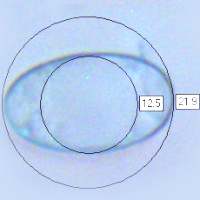 |
SporesBroadly ellipsoidal, smooth, monoguttulate, 19-22 x 11-13µm; hyaline. Spore printWhite. |
Odour/taste |
Not distinctive. |
Habitat & Ecological role |
Beside woodland paths, particularly in mixed woodland. |
Season |
Summer and autumn. |
Similar species |
Helvella ephippium is very similar but the underside of its cap is densely hairy. Helvella crispa has a fluted, broader stem with external grooves and internal hollow channels. Helvella lacunosa has a grey-brown or black cap and a broader stem with external grooves and internal hollow channels. |
Culinary Notes
Some field guides that cover edibility as a topic state that Helvella elastica is 'edible but of poor quality'. Suely, then, they are hardly worth collecting... unless you really enjoy eating elastic bands and are looking for a no-cost substitute. But lately concerns have been raised that Helvella fungi may contain carcinogens. What's the point of taking risks for such a dubious gain?
Reference Sources
Fascinated by Fungi, 2nd Edition, Pat O'Reilly 2016, reprinted by Coch-y-bonddu Books in 2022.
Dennis, R.W.G. (1981). British Ascomycetes; Lubrecht & Cramer; ISBN: 3768205525.
Breitenbach, J. & Kränzlin, F. (1984). Fungi of Switzerland. Volume 1: Ascomycetes. Verlag Mykologia: Luzern, Switzerland.
Medardi, G. (2006). Ascomiceti d'Italia. Centro Studi Micologici: Trento.
British Mycological Society (2010). English Names for Fungi
Dictionary of the Fungi; Paul M. Kirk, Paul F. Cannon, David W. Minter and J. A. Stalpers; CABI, 2008
Taxonomic history and synonym information on these pages is drawn from many sources but in particular from the British Mycological Society's GB Checklist of Fungi.
Acknowledgements
This page includes pictures kindly contributed by Simon Harding.
Fascinated by Fungi. Back by popular demand, Pat O'Reilly's best-selling 450-page hardback book is available now. The latest second edition was republished with a sparkling new cover design in September 2022 by Coch-y-Bonddu Books. Full details and copies are available from the publisher's online bookshop...
